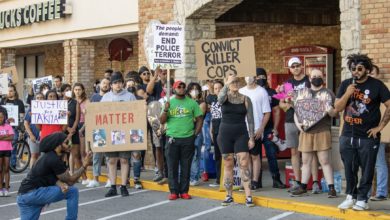At 7:30 p.m. on Feb. 20, Larry Davis was stabbed to death at the Shawangunk Correctional Facility in Wallkill, N.Y. In the late 1980s and early 1990s, Davis had become a folk-hero to the Black community in the Bronx and greater New York area after having shot six New York City cops in a raid, escaping unharmed and found not guilty on the most serious charges related to the shootout.
|
Larry Davis and defense attorney |
Davis, the youngest of 15 children, was only 20 years old when he first came into the public eye in 1986 as a young Black man who defied law enforcement, bringing attention to rampant police brutality and corruption in New York City. Davis came to embody the Black and Latino community’s anger at the police and at the time of his capture had already become a symbol of resistance.
On Nov. 19, 1986, a team of 27 officers and detectives assembled around the apartment building of two of Davis’ sisters where he had been staying. The police claimed Davis was a suspect in seven murders, including that of four drug dealers. Davis argued that the police sought to arrest him because he had been recruited into a drug ring by crooked cops who were afraid he would expose them.
Nine officers forced their way into the apartment. Davis and his girlfriend, along with his sister, her husband and their four children, were inside. Davis quickly retreated to a bedroom and yelled, “Don’t shoot! My babies are back here!”
A shootout ensued and Davis shot back, wounding six officers. Davis later said he only shot back in self-defense because he knew the cops were there to kill him.
When the police retreated from the apartment, he escaped through a back window. Davis proceeded to lead police on a nationwide manhunt, fearing that he would be beaten or killed by the cops for having wounded six officers.
In the 17 days that followed, raids were conducted in Chicago, Albany, Newark and other cities where Davis had family and friends.
His own mother was interrogated by police and suffered a heart attack. She recovered and begged that Davis arrange a safe surrender through the NAACP. But Davis knew that at the hands of the police his life had no guarantees.
On Dec. 5, 1986, police surrounded the apartment building of another one of Davis’ sisters after receiving a tip that he was seen entering the building. Davis forced his way into a neighbor’s apartment and held several people there. Many hours later, Davis was assured that he would not be harmed when police showed him the credentials of three reporters in a nearby apartment and allowed him to speak with his girlfriend. Davis then laid down his gun and surrendered.
As police took Davis out of the building in handcuffs, residents leaned out of their windows and chanted his name.
Davis defeats sham charges
Prosecutors in Manhattan and Long Island charged Davis with weapons possession, the murder of four drug dealers, attempted murder of police, kidnapping and car theft, among other things. After three trials in two years, they were unable to convince a jury to convict him on any of the charges except weapons possession, for which he was sentenced to 5 to 15 years in prison.
Lynne Stewart and William Kunstler, two long-time radical defense lawyers and activists, represented Davis. They argued that the four murder charges were frame-ups to raid Davis’ sister’s apartment and claimed that Davis had acted in self-defense because the police wanted to kill him for being part of a drug ring that also involved police. Davis was found not guilty for any of the four murders.
The second trial was for the attempted murder of the nine police officers who raided the apartment. The judge declared the first a mistrial because of biased jury selection and racist tactics. The second was also declared a mistrial after a white juror expressed concern about police harassment if he voted to acquit Davis. The final jury acquitted Davis of attempted murder and aggravated assault by reason of self defense. But he was finally convicted for six counts of criminal possession of a weapon.
According to an Oct. 18, 1987, New York Times article, Kunstler said that Davis was not named a suspect in any crime and no warrant for his arrest was issued until after the shootout at his sister’s apartment. The police acknowledged that claim.
Over 1,500 cops surrounded the courthouse after the verdict, demanding the maximum penalty. In 1991, Davis was also convicted of the murder of another drug dealer, Victor Lagombra, and was sentenced to an additional 25 years to life.
Police get their wishes
“You don’t shoot as many cops as I did, beat them at trial and ever go home a free man,” Davis was once quoted saying to Stanley Cohen, one of the first Bronx Legal Aid lawyers to take the case. In a recent interview, Cohen claimed Davis knew that the only way he would ever come out of prison was in a body bag.
The circumstances surrounding Davis’ death are, at best, highly questionable. He was repeatedly stabbed in the head, back, arms and chest with a 9-inch metal shank during recreational time on the Shawangunk Correctional Facility yard, which was overseen by several correctional officers.
State police have now arrested and charged another inmate, Luis Rosado, with the murder. Rosado and Davis have no records of previous violence against each other.
State officials and officers claim to know nothing about the murder of Davis, one of the men they most wanted dead just a few years ago.
The police do not hesitate to use extralegal methods when legal instruments of repression are insufficient. Circumstances warrant a thorough independent investigation of Davis’ killing.






